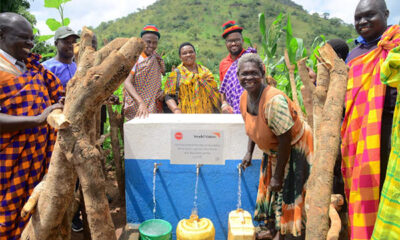Health
Malaria rising in rural areas despite bednet campaign

The US ambassador Scott DeLisi and President Museveni officiating at the launch of the bednet giveyout ceremon
According to a new two-year surveillance study published online in the American Journal of Tropical Medicine & Hygiene, suggesting that more aggressive methods of controlling the disease in high-transmission areas of sub-Saharan Africa including Uganda, are urgently needed.
The study, led by an international team of scientists, offers the most accurate, comprehensive and up-to-date measurement of the disease burden of malaria in Uganda, which is among the highest in sub-Saharan Africa.
“Our findings suggest that current efforts at controlling malaria may not be as effective as previously believed in high-transmission areas, where the disease is the biggest threat,” said Grant Dorsey, MD, PhD, a co-author of the study and professor of infectious diseases at the University of California, San Francisco. “It’s important to tell the less happy story that we have not yet seen advances in more rural areas, including at least two sites in Uganda, where transmission has been historically high.”
Steven Meshnick, a professor in the department of epidemiology at the University of North Carolina, Chapel Hill added: “The real take-home message of this study may be that malaria control in Africa requires sustained and consistent efforts over much more than two years.”
According to the study authors, the results indicate that high-transmission countries like Uganda will likely need to further scale up campaigns to distribute insecticide-treated bednets and spray homes with insecticides, while also considering new interventions such as using malaria drugs for prevention and controlling mosquito larvae in order to match the malaria reduction successes seen elsewhere in the world.
Since 2000, global investments in many types of malaria control are estimated to have resulted in a 47 percent drop in the disease’s global mortality rate and a 58 percent decrease in the mortality rate among African children, according to the World Health Organization.
While access to the most current malaria medications has dramatically increased in Uganda, use of other recommended interventions is less widespread, according to the authors. Studies show that only up to 36 percent of households have at least one long-lasting insecticide treated bednet (LLIN). And only 6 to 7 percent of households in Uganda reported receiving indoor residual spraying with insecticides between 2006 and 2011.
According to the World Health Organization, an estimated 198 million people each year are infected globally, and at least 584,000 people, mostly children in sub-Saharan Africa, were estimated to have died from malaria in 2013. Symptoms of the disease range from fever, headache, chills and vomiting to severe anemia, respiratory distress, seizures and organ failure. Malaria is curable if diagnosed and treated early with anti-malarial medications.
The study initially enrolled 755 children between the ages of 6 months and 10 years from 300 houses randomly selected from three areas of Uganda with differing malaria characteristics.
While the incidence of malaria infection decreased slightly in the relatively low-transmission, peri-urban Walukuba area during the study’s 24 months, it increased in the two rural areas. Episodes of malaria per person per year rose from an average of 0.97 to 1.93 in the moderate-transmission area of Kihihi and rose from an average of 2.33 to 3.30 in Nagongera, a high-transmission rural area near the southeastern border with Kenya.
The families were provided with bednets and had access to 24-hour medical care free of charge at a designated study clinic for episodes of fever. The children were also routinely tested for malaria every three months, whether they had symptoms or not. In addition, mosquito specimens were collected monthly from light traps strategically placed in each house to estimate the percentages of mosquitoes in the study areas that were carriers of malaria.
Healthcare workers provided over 2,500 treatments for malaria over the course of the study.
“Children in our study experienced a significantly high rate of infection, and that rate increased in the two rural areas,” said Dorsey. “Based on prior data, our higher transmission sites are very likely to be representative of most of Uganda and perhaps of most other rural areas in sub-Saharan Africa as well.”
“We have been getting used to good news in the fight against malaria, but this is not good news,” said Christopher Plowe, president of the American Society of Tropical Medicine and Hygiene. “Sixty years ago it was thought that no more research on malaria was needed—we just needed to use the tools we had. This study shows how important it is to have good data at the local level, and not rely on a one-size-fits-all approach. Research is critical to malaria elimination.”
The bednet campaign was funded by the United States, UK and the UNICEF.
Comments


















